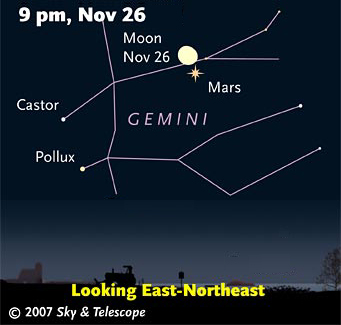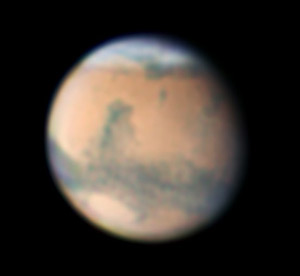Have you seen Mars yet? It's the brightest "star" that gets high in the sky from mid-northern latitudes, so it's not hard to spot. But if you had any doubts about which star is Mars, tonight's the time to lay them to rest. Around midnight EST (9 p.m. PST on November 26th), the Moon passes less than 1½° — three Moon-widths — from the planet.

The Moon passes 1½° north of Mars around midnight EST on the night of November 26–27.
S&T Illustration
The Moon and Mars rise before 9 p.m. at most locations in the Northern Hemisphere, and they're pretty high by 10 p.m. Take a look and see what you can see. The Moon is so dazzling that it makes any nearby star or planet seem dimmer. Mars is several times brighter than yellowish Capella two fist-widths above it or reddish Betelgeuse two fist-widths to the right, but the Moon's proximity might actually make Mars seem fainter than those stars. What's your impression?
This is also a great time to view Mars through a telescope. It now appears 14.7 arcseconds across, nearly as big as the 15.9 arcseconds that it will show on December 18th, when it's closest to Earth. Wait until the planet is high in the sky, 11 p.m. or so, and give your telescope plenty of time to adjust to the outside temperature. Then use the highest magnification that still shows the planet as reasonably crisp.

The dark triangle of Syrtis Major juts upward in this image of Mars taken by S&T's Sean Walker on the morning of November 19th. Above it is a hood of whitish clouds capping the north pole. And note the bright haze filling the Hellas Basin, the oval feature near the limb at the 7 o'clock position. Mars was 14 arcseconds wide, and the central-meridian longitude was 269°. Walker used a 12½-inch reflector, a DMK 21AF04.AS camera, and CS RGB color filters.
S&T: Sean Walker
Don't be surprised if Mars appears quite small. It's quite a lot farther from us than it was during its last really close approach to Earth, in 2003. Even so, a good telescope should show quite a bit of detail on the planet at 150× or higher, assuming that the atmospheric conditions are good. If the view wavers or appears fuzzy, try again on another night, when the air may be steadier.
The most obvious features on Mars right now are the North Polar Hood, a band of clouds that hangs over Mars's cold north pole, and the dark triangle of Syrtis Major. Both are shown well in the image at right. But you'll only be able to see Syrtis Major if it's facing Earth when you're looking — which isn't the case in North America this evening. Use our Mars Profiler to see which side of Mars is facing you. And make sure that you set your time-zone offset correctly!
 0
0









Comments
You must be logged in to post a comment.